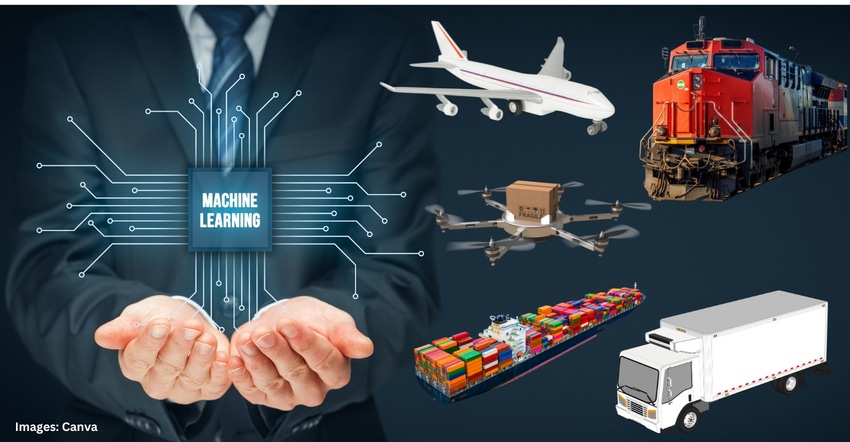A Reality Check on the Future of AI and Machine Learning for Packaging
We see six ways artificial intelligence and machine learning can help you improve your supply chain. But four obstacles stand in the way.

The science behind — and growth of — artificial intelligence (AI) and machine learning (ML) technologies have hit record highs. So what’s on everyone’s mind? ChatGPT is a biggie, not to mention AI and ML’s roles in supply chain innovations.
Let’s dive in.
What is ChatGPT and why does it matter?
For those living under a rock: OpenAI’s ChatGPT (generative pre-trained transformer) is an advanced chatbot that uses the massive repository of text on the internet to attempt to communicate like a human. Its inception has rocked an enormous number of fields — writers, designers, historians, educators. Everyone is nervous about how this technology can potentially change creative and educational landscapes.
A recent article in Fortune, “ChatGPT Creates an AI Frenzy,” quoted one professor who cautioned, “AI poses a real and imminent threat to the fabric of society. By lowering the cost of producing bogus information to merely zero, systems like ChatGPT are likely to unleash a tidal wave of disinformation.” In fact, school districts throughout the US and Australia have blocked school-administered networks from accessing chatbots. Australia has gone as far as to revert to “using only proctored, paper-based exams to assess students.”
By the way, according to a recent story, “ChatGPT has been banned in its entirety in China. They are calling the tool an instrument of Western propaganda.”
Other considerations:
• ChatGPT can only produce data from before 2021.
• The latest version “still has many known limitations, such as social biases, hallucinations, and adversarial prompts.”
• Filters are not currently effective enough to catch inappropriate content.
• ChatGPT does not currently link to sources.
• Intellectual property rights are up for grabs: “When an AI platform exposes a new product design or concept, who owns it? What if it plagiarizes based on its data model?”
• ChatGPT is a serious threat to education. Consider what future generations stand to lose, such as the ability to problem solve, write a thesis, and argue its merits and flaws, or the ability to create a business strategy that redefines the marketplace.
Regardless of its hiccups, this type of AI is blowing up, and competition is rising.
ChatGPT is all the rage.
The investment dollars going into it are mind blowing. Microsoft has committed to making a “multibillion dollar” contribution to the originator of ChatGPT, OpenAI. Add to that all the major players who are elbowing their way into the category with rival platforms, such as Amazon, Apple, and Google (called Bard).
Reality check: In its promotional video, Bard gave an incorrect answer, disappointed investors, and immediately lost $100 billion in value from parent Alphabet. Oops.
According to the New York Post, “One major shortcoming — salvation for reporters and copy editors — at least for now, is the tool’s inability to fact-check efficiently. You can ask it to provide an essay, to produce a story with citations, but more often than not, the citations are just made up. That’s a known failure of ChatGPT and honestly we do not know how to fix that.”
I do have to say, because I lead a design team: ChatGPT spits out some amazing images. But every client is seeking to stand out on shelf, online, and in people’s hearts. ChatGPT is up against human talent, experience, and deep knowledge of the client’s business.
“… human ingenuity is what created ChatGPT. My hope is that this type of platform will take on the more routine tasks and serve as the helpmate and not the master.”
So before you take a sledge hammer to your career, know that human ingenuity is what created ChatGPT. My hope is that this type of platform will take on the more routine tasks and serve as the helpmate and not the master.
Beyond ChatGPT, AI and ML are making waves in the supply chain, but not without issues.
Amazing leaps forward with machine learning.
Following conversations with executives across the supply chain industry, Forbes attempted to separate myth from reality. It begins with this definition: “Any device that can perceive its environment and takes actions that maximize its chance of success at a goal is some form of AI.”
But in the supply chain realm, machine learning (ML), or how AI uses data points and algorithms to “learn” without the help of humans, is where AI finds its true importance.
Photo credit: Pexels, Pavel Danilyuk
Where is ML breaking new ground?
We see six ways machine learning can aid product manufacturers:
1. Updating data, such as lead times for deliveries, is seeing advancements thanks to companies like AspenTech. Its process simulator performs thousands of actions to create large data sets where AI algorithms can be applied. The result? Its “first principles” model allows users to see improved accuracy up to 99+%.
2. ML for demand forecasting has advanced dramatically. One example: Forecasting how a product will sell in a particular area is only possible due to the latest version of ML. A cautionary note: Getting brands and retailers to enter this data has not met with much success.
3. ML and sustainability goals: Supply Chain Planning (SCP) can calculate the carbon footprint of every element in the supply chain, by machine, factory, distribution center (DC), mode of transportation, supplier, product material, and more. This type of feedback loop is possible as a result of using ML to embed self-correcting algorithms, taking the guesswork out of sustainability goals.
4. ML can predict machine breakdowns: Once again AspenTech is leading in this area. Using predictive analytics, users will be alerted to when vital machines in a refinery will break down and provide alternative production schedules.
5. Natural language processing (NLP): Suppose there’s a social media post saying that a company is about to “go belly up?” A machine can’t translate that kind of “unstructured” information. But using AI in supply chain applications, such as NLP, means that companies can flag this data before and help to mitigate it early.
6. AI helps predict order and inventory shortages: Turning a planning system into an execution aid and suggesting courses of action for demand/supply disruptions. For instance: A transportation system can apply ML to predict how long it will take a truck to make a delivery. A warehouse management system can predict what ecommerce customers are likely to purchase and assign correct work orders at the right time to the warehouse floor. And that’s just the start.
Reality Check: Although we’re seeing the design of new ML algorithms that amp up computing power, deliver big data analytics, and are being embraced by industry leaders, AI only fixed supply chains to a degree. It’s not a magic wand that makes supply chain issues disappear.
What’s holding us back?
Although AI is predicted to be a major tool in the supply chain armory, adoption has been hindered by four things:
1. Technology: Demystifying AI is still a problem for many organizations. The right tools are required to achieve enterprise-wide use. Many still suffer from data silos, which can result in missed opportunities and leave the company vulnerable to Black Swan events, such as COVID-19.
2. Processes: Data models are critical to a more seamless supply chain. And many supply chain groups have yet to step up with a plan. By leveraging the right technologies, processes can be put in place to enable clean, consistent, usable data. This is vital to any successful machine learning initiative.
3. People: Hiring the best talent is less a problem than removing barriers to cross-departmental collaboration. Teams need to understand the potential gains that are reachable through AI and ML to tie advances to the organization’s business goals.
4. Money: Of course, it goes without saying that investing in these innovative technologies is costly.
Applying AI and machine learning in the future.
Ask yourself, with all the advances in AI and machine learning, why are we still struggling with challenges that threaten the economy and human life?
• A train derailment that unleashes toxic chemicals, kills wildlife, and threatens people for decades to come?
• A fraudulent cryptocurrency business that collapses and loses billions.
• A bank failure that triggers similar failures in the financial markets setting off a global panic.
The above all happened in 2023! Could AI and ML have been applied to forecast such inherent dangers?
Time will tell.
Tom Newmaster has more than 25 years of experience in consumer packaged goods branding and package design. From 1998 to 2016, he led creative and won awards for The Hershey Co., Pfizer, Stoner Car Care, and Zippo. He has helped launch new products across multiple categories including fresh produce, frozen food, confectionery, household cleaning, and nutritional supplements, to name a few.
In 2017, Newmaster started FORCEpkg to take branding, design, and innovation to the next level. He has become a leading voice in the branding and packaging industry, writing for top trade and mainstream business publications.
About the Author(s)
You May Also Like




